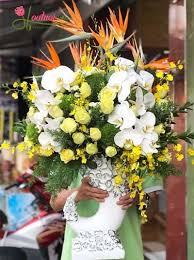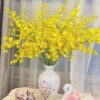# Exploring the Regions Cultivating Dancing Lady Orchids (*Oncidium*) Around the World


Dancing Lady Orchids, scientifically known as *Oncidium*, are among the most beloved and diverse genera of orchids. Their unique flower shapes, vibrant colors, and enchanting fragrances make them a favorite among orchid enthusiasts and collectors worldwide. Native to the tropical and subtropical regions of the Americas, these orchids have found their place in cultivation in various parts of the world. This article delves into the geographical regions where Dancing Lady Orchids thrive, exploring their natural habitats, cultivation practices, and the cultural significance attached to them.
## Table of Contents
1. [The Botanical Characteristics of Dancing Lady Orchids](#the-botanical-characteristics-of-dancing-lady-orchids)
2. [The Natural Habitat of Dancing Lady Orchids](#the-natural-habitat-of-dancing-lady-orchids)
3. [Major Regions Cultivating Dancing Lady Orchids](#major-regions-cultivating-dancing-lady-orchids)
– 3.1 [Central and South America](#central-and-south-america)
– 3.2 [North America](#north-america)
– 3.3 [Southeast Asia](#southeast-asia)
– 3.4 [Hawaii](#hawaii)
– 3.5 [Australia and New Zealand](#australia-and-new-zealand)
4. [Cultivation Practices Across Regions](#cultivation-practices-across-regions)
5. [Cultural Significance of Dancing Lady Orchids](#cultural-significance-of-dancing-lady-orchids)
6. [Conservation Efforts for Dancing Lady Orchids](#conservation-efforts-for-dancing-lady-orchids)
7. [Conclusion](#conclusion)
—
## 1. The Botanical Characteristics of Dancing Lady Orchids
Before delving into the regions where Dancing Lady Orchids are cultivated, it’s essential to understand their botanical characteristics. *Oncidium* orchids are characterized by:
– **Flower Structure**: The flowers of Dancing Lady Orchids often feature a distinctive shape, resembling a dancer in motion, with multiple petals that can be quite variable in color, ranging from yellow and orange to red and brown.
– **Growth Habit**: These orchids can be epiphytic (growing on trees), lithophytic (growing on rocks), or terrestrial (growing in the soil), showcasing a wide range of adaptability.
– **Size and Variability**: The size of *Oncidium* orchids can vary significantly, with some species featuring small blooms while others have larger, showy flowers. The diversity in size and color adds to their appeal in cultivation.
## 2. The Natural Habitat of Dancing Lady Orchids
Dancing Lady Orchids are native to diverse environments throughout Central and South America, as well as parts of the Caribbean. They thrive in:
– **Tropical Rainforests**: The warm, humid conditions of tropical rainforests provide an ideal environment for *Oncidium* species, where they can often be found growing on tree trunks and branches, receiving filtered sunlight through the canopy.
– **Cloud Forests**: In higher altitudes, *Oncidium* orchids adapt to the cooler, misty conditions of cloud forests, where moisture is abundant, and temperatures remain moderate.
– **Savannas and Grasslands**: Some species are found in drier habitats, including savannas and grasslands, demonstrating their adaptability to varying environmental conditions.
Understanding these habitats is crucial for cultivation and care, as replicating these conditions can significantly enhance the growth and flowering of Dancing Lady Orchids.
## 3. Major Regions Cultivating Dancing Lady Orchids
### 3.1 Central and South America
Central and South America is the heartland of *Oncidium* orchids, hosting a wide variety of species. Countries such as Brazil, Colombia, and Ecuador are renowned for their rich biodiversity, with numerous *Oncidium* species flourishing in their natural habitats.
– **Brazil**: Home to some of the most beautiful *Oncidium* species, Brazil’s diverse ecosystems offer ideal conditions for cultivation. The Amazon rainforest and the Atlantic rainforest are rich in orchid diversity, making Brazil a key player in the *Oncidium* market.
– **Colombia**: Known for its exceptional floral biodiversity, Colombia cultivates a range of orchids, including many *Oncidium* varieties. The country’s varied climates allow for the growth of both terrestrial and epiphytic orchids.
– **Ecuador**: Ecuador is famous for its rich orchid species diversity, with many *Oncidium* varieties endemic to the region. The country’s lush landscapes and favorable climate make it an ideal location for orchid cultivation.
### 3.2 North America
While *Oncidium* orchids are primarily tropical, certain species have adapted to the temperate climates found in parts of North America. The cultivation of Dancing Lady Orchids has become increasingly popular in the United States, especially in states like Florida and California.
– **Florida**: With its warm climate and abundant humidity, Florida provides a suitable environment for growing *Oncidium* orchids. Many enthusiasts cultivate them in home gardens, and commercial nurseries offer a variety of *Oncidium* species.
– **California**: The climate in California, particularly in coastal areas, is conducive to orchid cultivation. Here, hobbyists and commercial growers alike cultivate *Oncidium* orchids, often showcasing them at local flower shows and exhibitions.
### 3.3 Southeast Asia
Southeast Asia is another significant region for *Oncidium* cultivation, particularly in countries like Thailand, Malaysia, and Indonesia. The warm and humid tropical climate is ideal for growing these orchids, making them a common sight in gardens and commercial nurseries.
– **Thailand**: Known as the “Orchid Kingdom,” Thailand is a major producer of orchids, including *Oncidium*. The country hosts numerous orchid fairs and exhibitions, celebrating the diversity of orchids, including the popular Dancing Lady Orchid.
– **Malaysia and Indonesia**: Both countries have rich biodiversity and are known for their extensive orchid collections. Local growers often cultivate *Oncidium* orchids for both domestic and international markets, contributing to the global orchid trade.
### 3.4 Hawaii
Hawaii has gained recognition for its orchid cultivation, particularly *Oncidium* orchids, which thrive in the islands’ warm and humid climate. Hawaii is home to numerous orchid nurseries that specialize in both native and exotic species.
– **Commercial Cultivation**: The state’s orchid industry is significant, with many nurseries producing *Oncidium* for local sales and export. The annual Hawaii Orchid Society Show attracts orchid enthusiasts from around the world, highlighting the beauty and diversity of orchids grown in the islands.
### 3.5 Australia and New Zealand
Australia and New Zealand also cultivate *Oncidium* orchids, although they are not native to these regions. Enthusiasts have successfully grown these orchids, adapting their care to suit the local climate.
– **Australia**: In Australia, particularly in Queensland and New South Wales, *Oncidium* orchids are grown both in home gardens and commercial nurseries. The country’s diverse climates, from tropical to temperate, allow for various cultivation practices.
– **New Zealand**: While *Oncidium* orchids are less common in New Zealand, they are still cultivated by dedicated orchid enthusiasts who appreciate their beauty and uniqueness.
## 4. Cultivation Practices Across Regions
Cultivation practices for Dancing Lady Orchids vary by region due to differences in climate, available resources, and cultural preferences. However, several common practices exist that can enhance the growth and flowering of *Oncidium* orchids.
– **Growing Medium**: Most *Oncidium* orchids thrive in well-draining growing mediums. Commonly used materials include bark, sphagnum moss, and perlite. Some growers opt for specialized orchid mixes available at garden centers.
– **Watering**: Proper watering is crucial for orchid health. Generally, *Oncidium* orchids prefer to dry out slightly between waterings. Overwatering can lead to root rot, so monitoring moisture levels is essential.
– **Light Requirements**: *Oncidium* orchids enjoy bright, indirect light. While they can tolerate some direct sunlight, prolonged exposure can scorch their leaves. Growers often place them near windows with filtered light or use grow lights indoors.
– **Fertilization**: Regular fertilization during the growing season encourages healthy growth and blooming. A balanced, water-soluble fertilizer diluted to half strength is typically recommended for orchids.
– **Humidity and Temperature**: *Oncidium* orchids prefer high humidity levels (around 50-70%) and moderate temperatures. In regions with low humidity, growers often use humidity trays or mist the plants regularly.
– **Pest Management**: Common pests that affect *Oncidium* orchids include aphids, mealybugs, and spider mites. Regular inspection and the use of insecticidal soap or neem oil can help manage infestations.
By adopting these cultivation practices, orchid enthusiasts can create optimal conditions for Dancing Lady Orchids to thrive.
## 5. Cultural Significance of Dancing Lady Orchids
Dancing Lady Orchids hold cultural significance in many regions where they are cultivated. In various cultures, orchids symbolize beauty, luxury, and strength. Specific cultural meanings and practices associated with *Oncidium* include:
– **Festivals and Celebrations**: In some cultures, orchids are integral to festivals and celebrations. For example, in Southeast Asia, floral arrangements featuring *Oncidium* orchids are common during cultural festivals, weddings, and other significant events.
– **Gifts and Symbolism**: Orchids, including *Oncidium*, are often given as gifts to express love, admiration, and respect. They are popular choices for special occasions like anniversaries,
graduations, and birthdays.
– **Art and Representation**: The unique beauty of *Oncidium* orchids has inspired artists, photographers, and designers. Their intricate forms and vibrant colors are often depicted in paintings, textiles, and jewelry.
– **Traditional Medicine**: In some cultures, certain *Oncidium* species are believed to have medicinal properties. Local communities may use them in traditional remedies, although this practice varies widely by region.
## 6. Conservation Efforts for Dancing Lady Orchids
As the popularity of *Oncidium* orchids grows, so does the need for conservation efforts to protect their natural habitats. Several initiatives are underway to preserve these beautiful orchids:
– **Habitat Preservation**: Protecting the natural habitats where *Oncidium* orchids thrive is crucial for their survival. Conservation organizations work to preserve tropical rainforests and cloud forests, ensuring that these ecosystems remain intact.
– **Cultivation and Propagation**: Many nurseries and botanical gardens engage in the propagation of *Oncidium* orchids to promote their cultivation. By growing orchids in controlled environments, these organizations help reduce pressure on wild populations.
– **Awareness and Education**: Educating the public about the importance of orchids and their conservation is essential. Workshops, seminars, and community programs raise awareness and encourage responsible orchid ownership.
– **Legislation**: Some countries have implemented laws and regulations to protect endangered orchid species. International agreements, such as the Convention on International Trade in Endangered Species (CITES), help regulate the trade of orchids to prevent overexploitation.
## 7. Conclusion
Dancing Lady Orchids (*Oncidium*) are a captivating group of orchids that thrive in various regions worldwide. From their rich native habitats in Central and South America to their successful cultivation in places like Southeast Asia, Hawaii, and Australia, these orchids hold a special place in the hearts of orchid enthusiasts.
Through understanding their cultivation practices, cultural significance, and conservation efforts, we can appreciate the beauty and diversity of Dancing Lady Orchids while ensuring their continued presence in our gardens and natural landscapes. Whether you’re a seasoned collector or a novice gardener, the allure of *Oncidium* orchids is undeniable, and their vibrant blooms can bring joy to any space.

